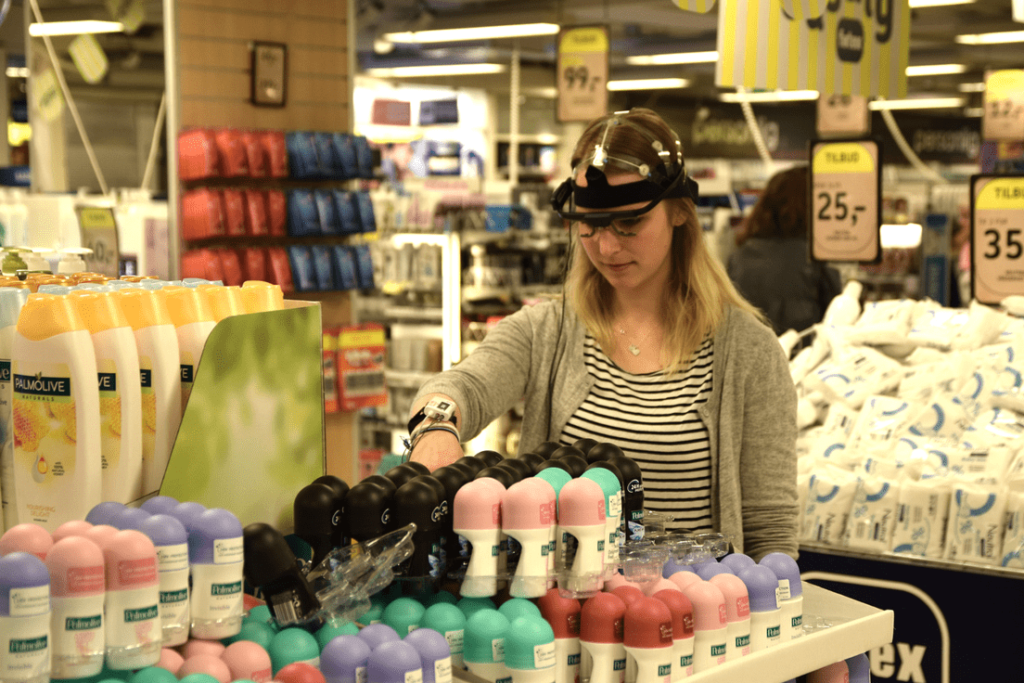Intro:
Retail environments are no longer just about displaying products, and expecting consumers to select from them. They have become multi-sensory and cognitive experiences that engage customers at different levels, driving split-second responses that impact purchase intentions in multiple ways. By understanding more about the way our brains work in retail environments, retailers and suppliers can create an enriched interaction that influences customer behaviour and decision-making. This interaction can be labelled as Customer Experience or ‘CX’.
It’s not always easy to understand why humans make certain purchase decisions, even our own decisions. Despite being the source of our thoughts and actions, our conscious mind can be surprisingly limited when it comes to explaining the reasons behind our decisions, as many of the factors that influence our choices operate and occur at a subconscious level.
Retail experiences facilitate the critical point of interaction between customers and brands. The positioning, orientation, colour schemes, labelling and cue related information all have a profound impact on our behaviour. Combined with the relative effectiveness of one object or product against competing information is ultimately what affects buying decisions. Remarkably, the human brain can process all of this information and make a decision in a matter of milliseconds.

Why Use Neuroscience
For decades, behavioural and self-report techniques have been used to understand consumer psychology, motivations, decisions, and intentions. The truth is, our opinions are a poor predictor of behaviour, and there is almost always a gap between our conscious or stated intentions, and the emotions that drive our behaviour.
Which should come as no surprise to anyone, as we often end up leaving a store with any amount of products that we had no pre-existing intent of purchasing, and zero conscious deliberation while picking the product up. Not to mention, the constant external emotional impact of marketing influencing our actions.
Methods from neuroscience can support shopper marketing and category management efforts to improve in-store displays and product showcasing by providing a novel approach to understanding consumer behaviour and preferences at a more granular level, and helping to quantify the impact and effectiveness of in-store promotions or merchandising.

RETAILER INSIGHT #1 – EASY DOES IT
Have you ever sat in a restaurant with an overloaded menu? Strangely, despite there being countless options for you to choose from, it’s still remarkably difficult to select what you want to order. This phenomenon is called ‘Paralysis by Analysis’, the logic here is that complexity is taxing on the brain, and once cognitive load exceeds a certain threshold, we suffer from confusion, stress and indecision. The brain avoids conditions like this.
A recent study conducted by conducted by Chynał, et al (2016), combined EEG, Eye-Tracking, subjective and behavioural data, to evaluate the impact that retail store layouts and designs have on consumer responses.
Evidence shows that complex store layouts negatively impact cognitive workload and consumer recall, ultimately leading to lighter baskets and trolleys.
For instance, perhaps products may not be sufficiently distanced or lack visual cues or prompting information across categories. This will drive inertia, inaction leading to reduced purchase intent and product/brand recall.
In simple terms, a ‘Less is More’ approach can drive positive outcomes. Simpler store layouts are more effective in terms of facilitating decision making by reducing cognitive workload, making it as easy as possible on consumer’s brain to increase desired results in memory encoding, positive approach motivation and product recall towards various brands and products.
RETAILER INSIGHT #2 – MEASURE TWICE, CUT ONCE
Unlock the power of your customers’ minds! EEG technology can help retailers identify the most effective advertising messages and images that engage and persuade consumers. This information can be used to optimise the effectiveness of marketing and media strategies, to drive shopping and ultimately improve the ROI of advertising spend.
Venkatraman et al.,(2017) ran an experiment with a retailer selling their own-brand range of health supplements in addition to competitor ranges. Their objective was to determine the most effective advertising messaging to promote their new line of organic products. The company conducted an EEG study, that in summary, showed different combinations of branding and advertising messages to consumers while interpreting their brain activity. This allowed for an objective measure of effectiveness of each brand and message combination.
Results revealed that advertising messages emphasising organic and natural ingredients elicit the strongest emotional response and triggers the highest engagement with consumers (Dulabh, 2019.).
As a result, the retailer was objectively able to identify what messages triggered the right type of brain activity that generated sales. Using this information they tailored communications to drive impact. The enhanced messaging generated the ROI increase of over 15% and conversion rates rose from 1.8% to 5%.
Oftentimes, the creative and strategy process can be influenced by biases that brand or agency teams project onto their data, or through primitive concept testing methods such as surveys or focus groups. By using EEG, we can objectively quantify what is actually effective, by measuring the impact that it has on consumers brains, rather than what their conscious mind can tell us when questioned.
RETAILER INSIGHT #3 – Co-create with your customers brains!
Retailers are at the forefront of innovation, constantly pushing to gain competitive advantage through innovation. Whether it’s a new in-store experience, a new product range or brand new ways to shop. It can be very rewarding for retailers to close the gap between customer’s needs or motivations and a new product or innovation. And what better way to close the gap than involving their brains in the creative process?
New products and innovations can have many different features, benefits and claims. But it is important for retailers to understand which features and attributes drive the most positive emotional responses. Neuroscience can give retailers this missing piece of the puzzle, by measuring the impact of features or attributes directly from the brain. This reliable data can be used to develop and refine products and experiences that better meet consumer needs and preferences, serving as a predictor of a successful product launch.
Golnar-Nik, et al.(2019), designed a pilot study to test how EEG could contribute during the product development life cycle. These elements were used to conduct an EEG study where participants were shown different smartphone designs and specs to determine which are the most appealing to consumers. The results revealed that designs with curved edges and a larger screen size elicit the strongest emotional response and cognitive processing among the participants. In general, science has shown that humans preferred curved designs and more interestingly, curved objects in general.
The usage of these approaches could lead a more user-centric design where product development becomes a more tailored process around human brain responses. This rich data source can become a truly valuable feedback, at different product life cycle stages, reducing risks and improving the customer experience.

SUMMARY:
Understanding the neuroscience of shopper marketing can revolutionise the way retailers and suppliers interact with customers and boost sales. With the help of technologies like EEG, retailers can design simpler store layouts, optimize advertising messages, and co-create products that resonate with consumers on a subconscious level, far beyond the capabilities of competing research methodologies. By delving into customers’ cognitive experiences, retailers can try to outline a shopping experience that engages the brain and ultimately drives purchase intent and desired business outcomes.
REFERENCES:
- Chynał, P., Sobecki, J., Rymarz, M., & Kilijańska, B. (2016, July). Shopping behaviour analysis using eyetracking and EEG. In 2016 9th International Conference on Human System Interactions (HSI) (pp. 458-464). IEEE.
- Venkatraman, V., Dimoka, A., Pavlou, P. A., Vo, K., Hampton, W., Bollinger, B., & Winer, R. S. (2015). Predicting advertising success beyond traditional measures: New insights from neurophysiological methods and market response modeling. Journal of Marketing Research, 52(4), 436-452.
- Golnar-Nik, P., Farashi, S., & Safari, M. S. (2019). The application of EEG power for the prediction and interpretation of consumer decision-making: A neuromarketing study. Physiology & behavior, 207, 90-98.
- Bar, M., & Neta, M. (2006). Humans prefer curved visual objects. Psychological science, 17(8), 645-648.
- Dulabh, Meera R. Analysing Cognitive Emotional and Behavioural Engagement to Interactive Retail Websites using Electroencephalogram (EEG) Technology and Surveys. The University of Manchester (United Kingdom), 2019.






